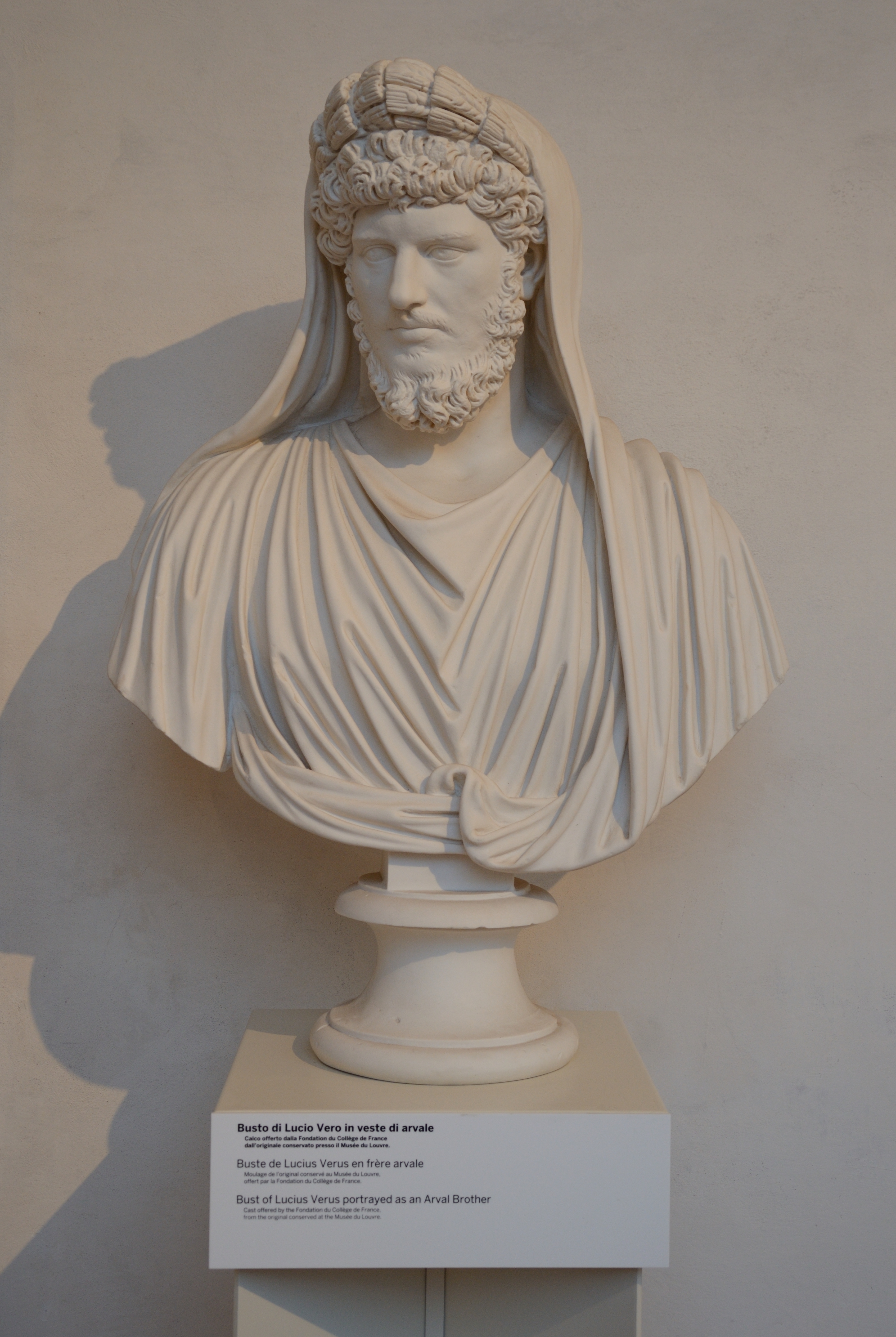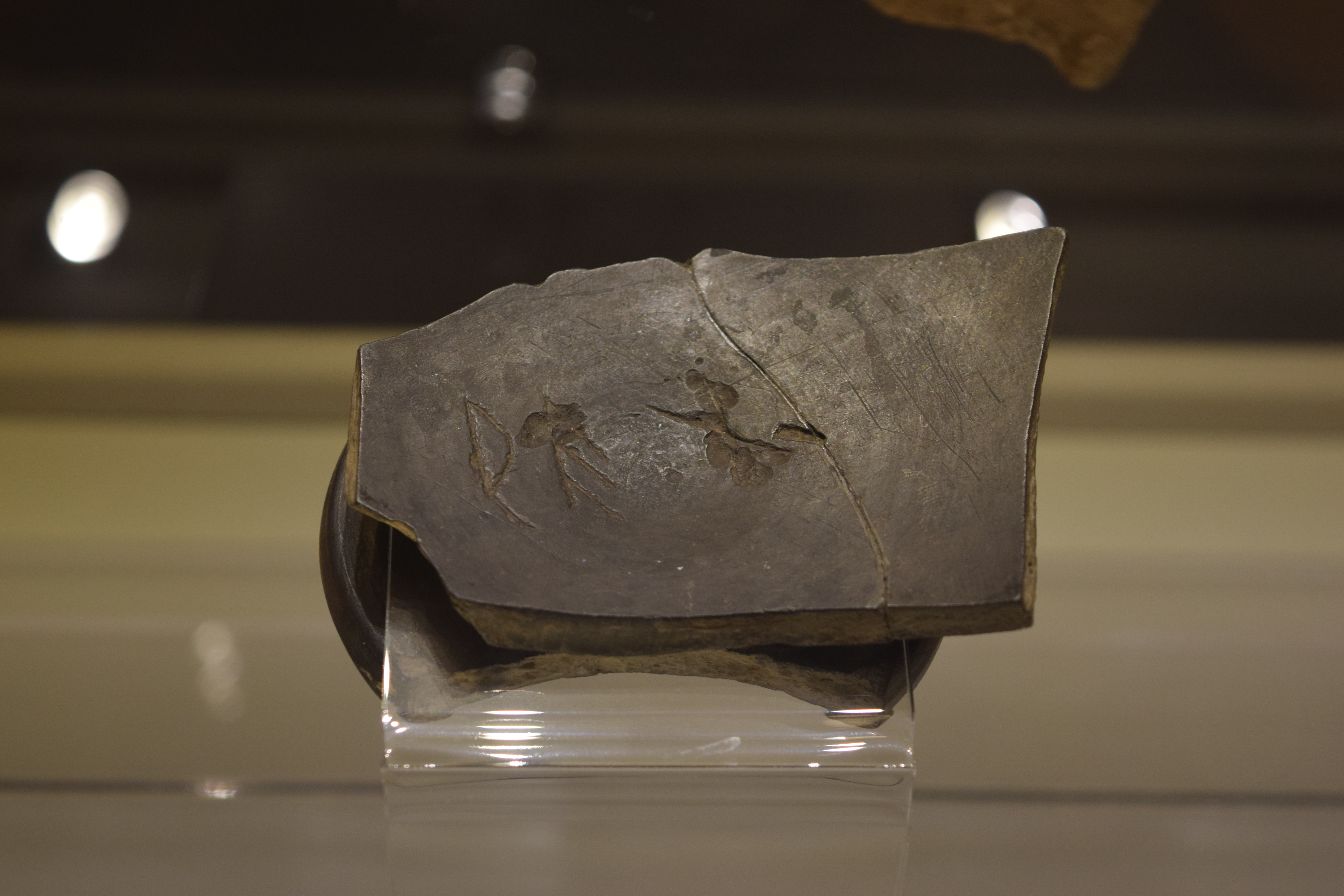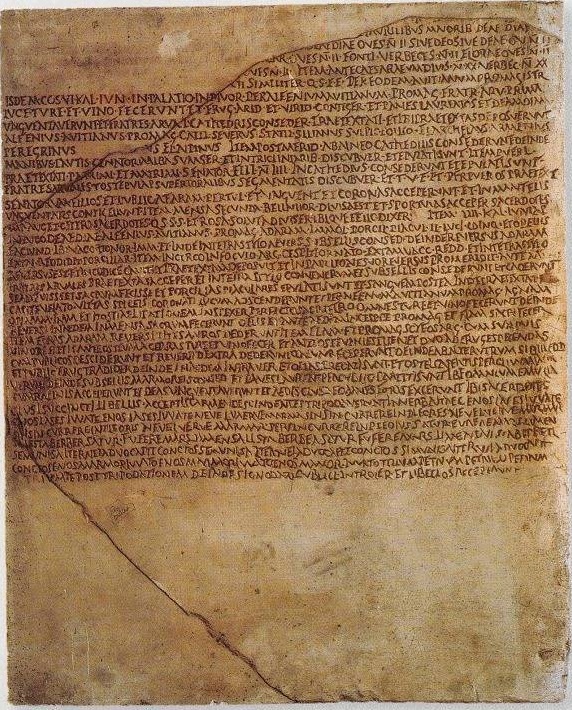|
Arvales
In ancient Roman religion, the Arval Brethren ( la, Fratres Arvales, "Brothers of the Fields") or Arval Brothers were a body of priests who offered annual sacrifices to the Lares and gods to guarantee good harvests. Inscriptions provide evidence of their oaths, rituals and sacrifices. Origin Roman legend held that the priestly college was originated by Romulus, first king of Rome, who took the place of a dead son of his nurse Acca Laurentia, and formed the priesthood with the remaining eleven sons. They were also connected originally with the Sabine priesthood of ''Sodales Titii'' who were probably originally their counterpart among the Sabines. Thus, it can be inferred that they existed before the founding of the city.Aulus Gellius VII 7, 7; Pliny XVII 2, 6. There is further proof of the high antiquity of the college in the verbal forms of the song with which, down to late times, a part of the ceremonies was accompanied, and which is still preserved. They persisted to the ... [...More Info...] [...Related Items...] OR: [Wikipedia] [Google] [Baidu] |
Acta Arvalia
The ''Acta Arvalia'' were the recorded protocols of the Arval Brothers ''(Arvales fratres)'', a priestly brotherhood ('' sodalitas'') of ancient Roman religion. The ''acta'' were inscribed in marble tablets fastened to the walls of the Temple of Dea Dia, goddess of the grove, near the present borough of the Magliana Vecchia, between the right bank of the Tiber and the hill Monte delle Piche. The oldest of the protocols are evidence of early Latin. They are mentioned by Varro. "The transcription of the records of this priesthood onto stone provided possibly the biggest coherent complex of inscriptions of the Roman ancient world," Jörg Rüpke has observed. The ''acta'' document routine rituals and special occasions, the ''vota'' of participating members, the name of the place where sacrifices occurred, and specific dates. They are an important source for ancient Roman prosopography and a useful one for the study of Rome's distinctive archaic religious traditions. Actual litu ... [...More Info...] [...Related Items...] OR: [Wikipedia] [Google] [Baidu] |
Acca Laurentia
Acca Larentia or Acca Larentina was a mythical woman, later goddess of fertility, in Roman mythology whose festival, the Larentalia, was celebrated on December 23. Myths Foster mother In one mythological tradition (that of Licinius Macer, et al.), she was the wife of the shepherd Faustulus. And after Romulus and Remus were thrown into the Tiber river, Faustulus brought them back to his home, where Acca Larentia would raise the children. She had twelve sons, and on the death of one of them Romulus took his place. and with the remaining eleven founded the college of the Arval brothers (Fratres Arvales). She is therefore identified with the Dea Dia of that collegium. The flamen Quirinalis acted in the role of Romulus (deified as Quirinus) to perform funerary rites for his foster mother. Benefactor of Rome Another tradition holds that Larentia was a beautiful girl of notorious reputation, roughly the same age as Romulus and Remus, during the reign of Ancus ... [...More Info...] [...Related Items...] OR: [Wikipedia] [Google] [Baidu] |
Religion In Ancient Rome
Religion in ancient Rome consisted of varying imperial and provincial religious practices, which were followed both by the people of Rome as well as those who were brought under its rule. The Romans thought of themselves as highly religious, and attributed their success as a world power to their collective piety ''( pietas)'' in maintaining good relations with the gods. Their polytheistic religion is known for having honored many deities. The presence of Greeks on the Italian peninsula from the beginning of the historical period influenced Roman culture, introducing some religious practices that became fundamental, such as the '' cultus'' of Apollo. The Romans looked for common ground between their major gods and those of the Greeks ('' interpretatio graeca''), adapting Greek myths and iconography for Latin literature and Roman art, as the Etruscans had. Etruscan religion was also a major influence, particularly on the practice of augury, used by the state to seek the ... [...More Info...] [...Related Items...] OR: [Wikipedia] [Google] [Baidu] |
Dea Dia
Dea Dia (Latin: "Goddess of Daylight", or "Bright Goddess") was a goddess of fertility and growth in ancient Roman religion. She was sometimes identified with Ceres, and sometimes with her Greek equivalent Demeter. She was worshiped during Ambarvalia, a festival to Ceres. Every May, her priests, the Fratres Arvales In ancient Roman religion, the Arval Brethren ( la, Fratres Arvales, "Brothers of the Fields") or Arval Brothers were a body of priests who offered annual sacrifices to the Lares and gods to guarantee good harvests. Inscriptions provide eviden ..., held a three-day festival in her honor.Notes on Strabo's account 5.3/ref> Name The name ''Dea Dīa'' () means 'Goddess of Daylight' or 'Bright Goddess'. The first element stems from the Latin ''dea'' ('goddess'), while the second is related to ''diēs'' ('day'), probably in reference to the ritual prescription to announce in January the May ceremonies ''sub divo culmine'' ('under the celestial vault'). See also ... [...More Info...] [...Related Items...] OR: [Wikipedia] [Google] [Baidu] |
Regia
The Regia ("Royal house") was a two-part structure in Ancient Rome lying along the Via Sacra at the edge of the Roman Forum that originally served as the residence or one of the main headquarters of kings of Rome and later as the office of the '' pontifex maximus'', the highest religious official of Rome. It occupied a triangular patch of terrain between the Temple of Vesta, the Temple of Divus Julius and Temple of Antoninus and Faustina. Only the foundations of Republican/Imperial Regia remain. Like the Curia it was destroyed and rebuilt several times, as far back as the Roman monarchy. Studies have found multiple layers of similar buildings with more regular features, prompting the theory that this "Republican Regia" was to have a different use. History According to ancient tradition it was built by the second king of Rome, Numa Pompilius, as a royal palace. Indeed, the Latin term ''regia'' can be translated as ''royal residence''. It is said that he also built the Temple ... [...More Info...] [...Related Items...] OR: [Wikipedia] [Google] [Baidu] |
Carmen Arvale
The ''Carmen Arvale'' is the preserved chant of the Arval priests or ''Fratres Arvales'' of ancient Rome. The Arval priests were devoted to the goddess Dia, and offered sacrifices to her to ensure the fertility of ploughed fields (Latin ''arvum''). There were twelve Arval priests, chosen from patrician families. During the Roman Empire the Emperor was always an Arval priest. They retained the office for life, even if disgraced or exiled. Their most important festival, the Ambarvalia, occurred during the month of May, in a grove dedicated to Dia. The ''Carmen Arvale'' is preserved in an inscription dating from 218 AD, which contains records of the meetings of the Arval Brethren. It is written in an archaic form of Old Latin, likely not fully understood any more at the time the inscription was made. One of its interpretations goes as follows: :''enos Lases iuuate'' :''enos Lases iuuate'' :''enos Lases iuuate'' :''neue lue rue Marmar sins incurrere in pleores'' :''neue lu ... [...More Info...] [...Related Items...] OR: [Wikipedia] [Google] [Baidu] |
Toga Praetexta
The toga (, ), a distinctive garment of ancient Rome, was a roughly semicircular cloth, between in length, draped over the shoulders and around the body. It was usually woven from white wool, and was worn over a tunic. In Roman historiography, Roman historical tradition, it is said to have been the favored dress of Romulus, Rome's founder; it was also thought to have originally been worn by both sexes, and by the citizen-military. As Women in ancient Rome, Roman women gradually adopted the stola, the toga was recognized as formal wear for Roman citizenship, male Roman citizens. Women engaged in Prostitution in ancient Rome, prostitution might have provided the main exception to this rule.. The type of toga worn reflected a citizen's rank in the civil hierarchy. Various Roman law, laws and customs restricted its use to citizens, who were required to wear it for public festivals and civic duties. From its probable beginnings as a simple, practical work-garment, the toga became m ... [...More Info...] [...Related Items...] OR: [Wikipedia] [Google] [Baidu] |
Marcus Aurelius
Marcus Aurelius Antoninus (Latin: áːɾkus̠ auɾέːli.us̠ antɔ́ːni.us̠ English: ; 26 April 121 – 17 March 180) was Roman emperor from 161 to 180 AD and a Stoic philosopher. He was the last of the rulers known as the Five Good Emperors (a term coined some 13 centuries later by Niccolò Machiavelli), and the last emperor of the Pax Romana, an age of relative peace and stability for the Roman Empire lasting from 27 BC to 180 AD. He served as Roman consul in 140, 145, and 161. Marcus Aurelius was born during the reign of Hadrian to the emperor's nephew, the praetor Marcus Annius Verus, and the heiress Domitia Calvilla. His father died when he was three, and his mother and grandfather raised him. After Hadrian's adoptive son, Aelius Caesar, died in 138, the emperor adopted Marcus's uncle Antoninus Pius as his new heir. In turn, Antoninus adopted Marcus and Lucius, the son of Aelius. Hadrian died that year, and Antoninus became emperor. Now heir to the throne, ... [...More Info...] [...Related Items...] OR: [Wikipedia] [Google] [Baidu] |
Praetor
Praetor ( , ), also pretor, was the title granted by the government of Ancient Rome to a man acting in one of two official capacities: (i) the commander of an army, and (ii) as an elected '' magistratus'' (magistrate), assigned to discharge various duties. The functions of the magistracy, the ''praetura'' (praetorship), are described by the adjective: the ''praetoria potestas'' (praetorian power), the ''praetorium imperium'' (praetorian authority), and the ''praetorium ius'' (praetorian law), the legal precedents established by the ''praetores'' (praetors). ''Praetorium'', as a substantive, denoted the location from which the praetor exercised his authority, either the headquarters of his '' castra'', the courthouse (tribunal) of his judiciary, or the city hall of his provincial governorship. History of the title The status of the ''praetor'' in the early republic is unclear. The traditional account from Livy claims that the praetorship was created by the Sextian-Licinian Rogat ... [...More Info...] [...Related Items...] OR: [Wikipedia] [Google] [Baidu] |
Flamen
A (plural ''flamens'' or ''flamines'') was a priest of the ancient Roman religion who was assigned to one of eighteen deities with official cults during the Roman Republic. The most important of these were the three (or "major priests"), who served the important Roman gods Jupiter, Mars, and Quirinus. The remaining twelve were the ("lesser priests"). Two of the served deities whose names are now unknown; among the others are deities about whom little is known other than the name. During the Imperial era, the cult of a deified emperor () also had a flamen. The fifteen Republican flamens were members of the Pontifical College, who administered state-sponsored religion. When the office of flamen was vacant, a could serve as a temporary replacement, although only the is known to have substituted for the , one of the . Etymology The etymology of remains obscure, and perhaps undecidable. Andrew Sihler ''New Comparative Grammar of Greek and Latin,'' Oxford University Press 1995 ... [...More Info...] [...Related Items...] OR: [Wikipedia] [Google] [Baidu] |
Augustus
Caesar Augustus (born Gaius Octavius; 23 September 63 BC – 19 August AD 14), also known as Octavian, was the first Roman emperor; he reigned from 27 BC until his death in AD 14. He is known for being the founder of the Roman Principate, which is the first phase of the Roman Empire, and Augustus is considered one of the greatest leaders in human history. The reign of Augustus initiated an imperial cult as well as an era associated with imperial peace, the '' Pax Romana'' or '' Pax Augusta''. The Roman world was largely free from large-scale conflict for more than two centuries despite continuous wars of imperial expansion on the empire's frontiers and the year-long civil war known as the "Year of the Four Emperors" over the imperial succession. Originally named Gaius Octavius, he was born into an old and wealthy equestrian branch of the plebeian ''gens'' Octavia. His maternal great-uncle Julius Caesar was assassinated in 44 BC, and Octavius was named in Cae ... [...More Info...] [...Related Items...] OR: [Wikipedia] [Google] [Baidu] |







